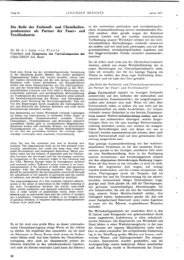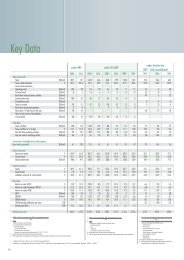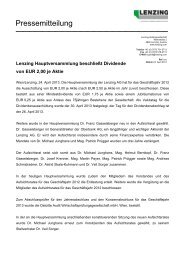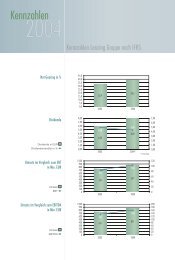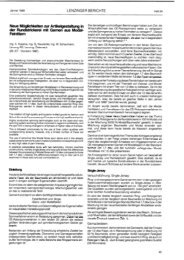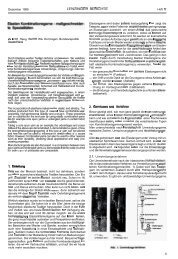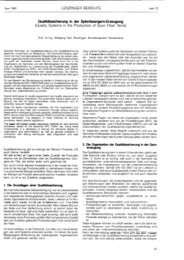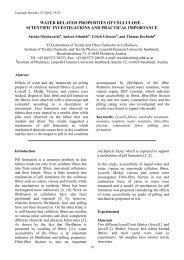THE SORPTION BEHAVIOUR OF CELLULOSE FIBRES - Lenzing
THE SORPTION BEHAVIOUR OF CELLULOSE FIBRES - Lenzing
THE SORPTION BEHAVIOUR OF CELLULOSE FIBRES - Lenzing
Create successful ePaper yourself
Turn your PDF publications into a flip-book with our unique Google optimized e-Paper software.
14.1%, lyocell 14.6%, viscose 15.1%). Viscose<br />
fibres show the highest water retention value,<br />
lyocell fibres follow. Water retention value of<br />
modal fibres is 15% lower then that of lyocell<br />
fibres and 32% lower then that of viscose fibres.<br />
As shown by the data in Figure 4, the increase in<br />
fibre width after swelling in water is also decreases<br />
from viscose fibres (36.3%) to lyocell<br />
fibres (22.0%) and is considerably smaller in the<br />
case of modal fibres (17.4%). The lowest value<br />
of water adsorption have the natural cellulose<br />
fibres (cotton), whose hydrophilic character increases<br />
from cotton NaOH cleaned to cotton<br />
mercerised.<br />
When considering water sorption, the new lyocell<br />
fibres are similar to the less dense, low crystalline<br />
and least oriented viscose fibres. Water<br />
vapour adsorption, water retention, swelling in<br />
water places lyocell fibres between the viscose<br />
and modal fibres. Contrary to expectations the<br />
sorption phenomena in the aqueous medium are<br />
not in agreement with the basic structural data<br />
i.e. degree of crystallinity and orientation factor<br />
(Table 1). In the case of cellulose fibres the<br />
structure of voids (especially their diameter and<br />
volume, and less inner surface) the fraction and<br />
orientation of amorphous areas are more important<br />
than other structural characteristics. The<br />
ordered regions (crystalline) do not contribute<br />
significantly to the process of water adsorption.<br />
In spite of the highest degree of crystallinity and<br />
orientation, lyocell fibers have excellent sorption<br />
properties, similar to those of viscose fibers due<br />
to their void system and amorphous region.<br />
ζ [mV]<br />
0<br />
-2<br />
-4<br />
-6<br />
-8<br />
-10<br />
-12<br />
-14<br />
-16<br />
Cotton 2% NaOH<br />
Cotton 24% NaOH<br />
Viscose<br />
Lyocell<br />
Modal<br />
2 4 6 8 10<br />
pH<br />
Figure 5. Zeta potential ζ as a function of the<br />
pH (conc. of electrolyte solution (KCl) = 0,001<br />
mol/l).<br />
32<br />
Differences are also observed regarding the zeta<br />
potential - pH functions (Figure 5), between the<br />
very hydrophilic regenerated and more crystalline<br />
cotton materials. The hydrophobic character<br />
of cotton in comparison to the hydrophilic character<br />
of regenerated fibres, is responsible for<br />
their highest negative surface charge. The highest<br />
negative zeta potential in the alkaline region,<br />
has boiled cotton fibres (ζplateau of Cotton<br />
2%NaOH = app. – 16 mV). The primary wall of<br />
cotton (location of non-cellulose compounds) at<br />
the fibre surfaces is destroyed using NaOH<br />
cleaning, causing higher accessibility of the surface<br />
groups (COOH). If cotton fibres are mercerised<br />
a decrease of ζplateau is observed, because of<br />
changed cellulose structure. The transformation<br />
of cellulose fine structure from cell I to cell II<br />
causes enlargement of the amorphous part of the<br />
fibre, which leads to the higher reactivity of the<br />
cellulose. The ζplateau values of structured cotton<br />
fibres become similar to those of the regenerated<br />
ones (ζplateau of Cotton 24%NaOH = app –10<br />
mV). The degree of swelling is increased by decreased<br />
crystallinity (the crystallinity of Cotton<br />
24%NaOH is reduced from 90% to 77%; according<br />
to iodine adsorption values ([23]). This is an<br />
explanation for the reduction of the ζplateau .<br />
The ζplateau value of modal is app. –9.5 mV, the ζ<br />
plateau of viscose is the smallest (app. –5 mV),<br />
probably due to the distinct reactive groups (OH<br />
and COOH) accessibility, which is determined<br />
by different structure of regenerated fibres ([1],<br />
[2]).<br />
Conclusion<br />
The results of the vapour adsorption, water retention<br />
power and swelling of different cellulose<br />
fibres show clear differences between the hydrophilic<br />
(viscos, lyocell) and the hydrophobic fibres<br />
(cotton, cotton-mercerised) which are in<br />
excellent correlation with the – pH function of<br />
cellulose fibres.<br />
The results of fibre reactivity and adsorption<br />
characteristics obtained by conventional methods,<br />
correlate with the electrokinetic character of<br />
materials – the natural fibres are less reactive as<br />
the regenerated one, so the ζmax of cotton is the<br />
highest. The hydrophilicity of cotton is improved<br />
by mercerisation (changed primary structureformation<br />
of cell II structure), but not as high as<br />
32



